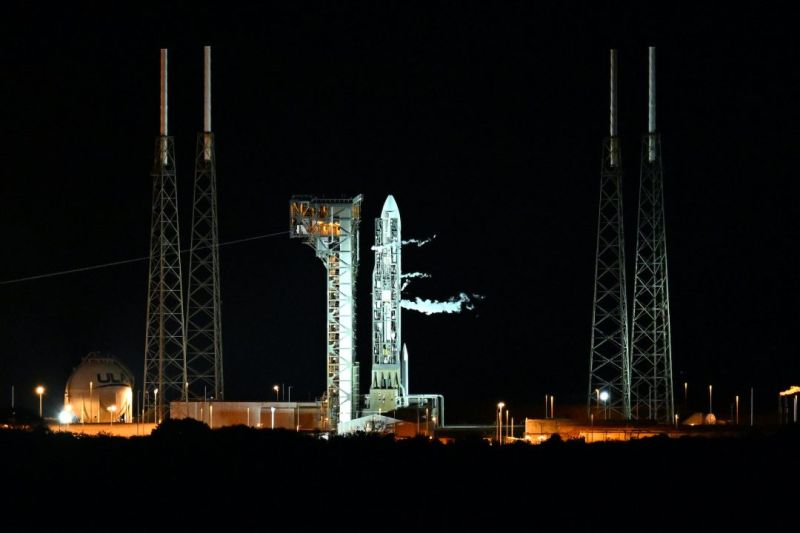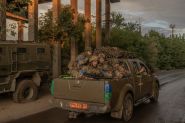
©(Photo by Chandan Khanna / AFP)
Fifty years later, the United States launched a spacecraft on Monday to attempt to land on the Moon. This new mission is led by NASA, in partnership with the private sector.
The first American spacecraft to attempt to land on the Moon in more than half a century blasted off early on Monday, but this time, private industry is leading the charge.
A brand new rocket, United Launch Alliance's Vulcan Centaur, lifted off from Cape Canaveral Space Force Station in Florida at 2:18 AM (0718 GMT) for its maiden voyage, carrying Astrobotic's Peregrine Lunar Lander.
If all goes to plan, Peregrine will touch down on a mid-latitude region of the Moon called Sinus Viscositatis, or Bay of Stickiness, on February 23.
Until now, a soft landing on Earth's nearest celestial neighbor has only been accomplished by a handful of national space agencies: the Soviet Union was first, in 1966, followed by the United States, which is still the only country to put people on the Moon. Neil Armstrong was the first astronaut to step on the Moon, on July 20, 1969.
China has successfully landed three times over the past decade, while India was the most recent to achieve the feat on its second attempt, last year.
Now, the United States is turning to the commercial sector to stimulate a broader lunar economy and ship its hardware at a fraction of the cost, under the Commercial Lunar Payload Services (CLPS) program.
 The United Launch Alliance (ULA) Vulcan Centaur rocket vents before taking off at Cape Canaveral Space Force Station in Cape Canaveral, Florida, on January 8, 2024. (Photo by Chandan Khanna / AFP)
The United Launch Alliance (ULA) Vulcan Centaur rocket vents before taking off at Cape Canaveral Space Force Station in Cape Canaveral, Florida, on January 8, 2024. (Photo by Chandan Khanna / AFP)
NASA paid Astrobotic more than $100 million for the task, while another contracted company, Houston-based Intuitive Machines, is looking to launch in February and land near the South Pole.
"We think that it's going to allow... more cost-effective and more rapidly accomplished trips to the lunar surface to prepare for Artemis," said Joel Kearns, the US space agency's deputy associate administrator for exploration.
Artemis is the NASA-led program to return astronauts to the Moon later this decade, in preparation for future missions to Mars.
Controlled touchdown on the Moon is a challenging undertaking, with roughly half of all attempts failing. In the absence of an atmosphere that would allow the use of parachutes, a spacecraft must navigate through treacherous terrain, only using its thrusters to slow descent.
Katrine Dige Houmøller, with AFP
The first American spacecraft to attempt to land on the Moon in more than half a century blasted off early on Monday, but this time, private industry is leading the charge.
A brand new rocket, United Launch Alliance's Vulcan Centaur, lifted off from Cape Canaveral Space Force Station in Florida at 2:18 AM (0718 GMT) for its maiden voyage, carrying Astrobotic's Peregrine Lunar Lander.
If all goes to plan, Peregrine will touch down on a mid-latitude region of the Moon called Sinus Viscositatis, or Bay of Stickiness, on February 23.
Until now, a soft landing on Earth's nearest celestial neighbor has only been accomplished by a handful of national space agencies: the Soviet Union was first, in 1966, followed by the United States, which is still the only country to put people on the Moon. Neil Armstrong was the first astronaut to step on the Moon, on July 20, 1969.
China has successfully landed three times over the past decade, while India was the most recent to achieve the feat on its second attempt, last year.
Now, the United States is turning to the commercial sector to stimulate a broader lunar economy and ship its hardware at a fraction of the cost, under the Commercial Lunar Payload Services (CLPS) program.
 The United Launch Alliance (ULA) Vulcan Centaur rocket vents before taking off at Cape Canaveral Space Force Station in Cape Canaveral, Florida, on January 8, 2024. (Photo by Chandan Khanna / AFP)
The United Launch Alliance (ULA) Vulcan Centaur rocket vents before taking off at Cape Canaveral Space Force Station in Cape Canaveral, Florida, on January 8, 2024. (Photo by Chandan Khanna / AFP)A Challenging Task
NASA paid Astrobotic more than $100 million for the task, while another contracted company, Houston-based Intuitive Machines, is looking to launch in February and land near the South Pole.
"We think that it's going to allow... more cost-effective and more rapidly accomplished trips to the lunar surface to prepare for Artemis," said Joel Kearns, the US space agency's deputy associate administrator for exploration.
Artemis is the NASA-led program to return astronauts to the Moon later this decade, in preparation for future missions to Mars.
Controlled touchdown on the Moon is a challenging undertaking, with roughly half of all attempts failing. In the absence of an atmosphere that would allow the use of parachutes, a spacecraft must navigate through treacherous terrain, only using its thrusters to slow descent.
Katrine Dige Houmøller, with AFP
Read more




Comments